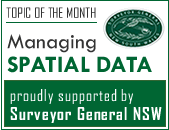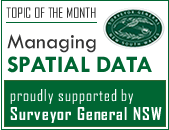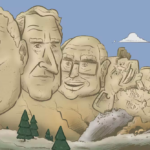Spatial Data is Ancient History

It’s a jar full of business cards on the restaurant counter. The question a museum asks you about your postcode. A registration form that’s the hiccough before you can read news on a website. A camera recording the longitude and latitude in the file data as it takes a photo.
“Augmented reality” is an up-and-coming way of viewing location-based information. But most people have been dealing with it non-digitally for a long time. Most people know where the list of postcodes lies – up the back of the White Pages. Most people can read a schematic map well enough to change train lines. Most people are on the voting roll.
 Spatial data existed well before the Internet. It used to belong to the rich, the notorious, the hated and the admired. After William the Conquerer claimed England from across the English channel, he commissioned a survey of his newly-conquered country in the form of the Domesday Book so he could levy taxes. The local people were now his “stuff”. And he wanted more data so he could know what he could do with them.
Spatial data existed well before the Internet. It used to belong to the rich, the notorious, the hated and the admired. After William the Conquerer claimed England from across the English channel, he commissioned a survey of his newly-conquered country in the form of the Domesday Book so he could levy taxes. The local people were now his “stuff”. And he wanted more data so he could know what he could do with them.
This used to be the norm – spatial data collected by the rich and powerful to help them enforce their control over everyone else. No one else could afford to collect it. Later, the data became more accessible – it was put in public registries, then in cheaper books. You still had to know what book to bring with you (if it was light enough), but you could bring useful gazetteers on the prowl. These gazetteers were already useful fifty years ago – the German air force crossed the same channel as William in 1942 to “bomb every building in Britain marked with three stars in the Baedeker [Travel] Guide”.
Herodotus’ ancient travel guide – The Histories – which collected stories about the ancient Mediterranean, also collected geography. The HESTIA Project is now busy transforming this ancient spatial data into modern data, linking his stories to his places; and his places to each other. Herodotus’ collection of data took a lot of deliberate time and effort, and Project HESTIA has similarly spent a lot of deliberate time and effort linking it to digital geography. It is not always so deliberate.
 Everyday lives deform infomation on the Internet like space-time is deformed by the masses of stars and planets. Faces are left next to monuments in photos, and opinions next to restaurants in reviews. These modern trails become spatial data almost by accident. Geographical friend networks are the core of Facebook, and cities are described on blogs and micro-blogs. ISPs broadcast their location websites, which use them to work out what country we’re in and stop us watching Hulu; or let us use iView. And now that these trails have been left, we can start combining them with what we want to know.
Everyday lives deform infomation on the Internet like space-time is deformed by the masses of stars and planets. Faces are left next to monuments in photos, and opinions next to restaurants in reviews. These modern trails become spatial data almost by accident. Geographical friend networks are the core of Facebook, and cities are described on blogs and micro-blogs. ISPs broadcast their location websites, which use them to work out what country we’re in and stop us watching Hulu; or let us use iView. And now that these trails have been left, we can start combining them with what we want to know.
Which is the other big innovation: how fast we can access that data. Simple tools like Google Maps can tell us where the nearest coffee shop is – without the benefit of GPS. The ABC can run a realtime map pinning news stories to their locations. In Chris Anderson’s book Free he describes an experiment by musician Derek Webb, who released his album “Mockingbird” for free online. In return, he asked the people downloading the album for “names, email addresses and zip codes”. Webb says that
since then, I’ve been able to filter that list by zip code to find out where my fans are and then email them to get them in the rooms (when touring). I sell out shows now.
This is an old-fashioned band mailing-list, bent to run on modern technology.
David Gelernter, from Yale University, has said:
"the chief goal of the personal-computer OS (is) providing a " ’documentary history’ of your life." Information technology, he argues, must answer the question "Where’s my stuff?"
For spatial data the main question, then is: “Where’s my stuff around here?” The stuff is no longer kingdoms, but personal things – like a list of local comments about Masterchef; or where you left your car. There’s nothing new about these questions. What’s new is the ease and the speed with which the answers have started arriving.
The tools to manage spatial data are available. For everybody. Right now.
Zacha Rosen is an ancient historian by training. He doesn’t know where he is right now, but his computer is willing to tell him.















